115th Carnival of Nuclear Energy Bloggers
The 115th Carnival of Nuclear Energy Bloggers is up

A message from NV5, Inc.
Seconds Matter: Rethinking Nuclear Facility Security for the Modern Threat Landscape
The 115th Carnival of Nuclear Energy Bloggers is up
The probable confirmation of the existence of the Higgs boson, announced on Wednesday, July 4, 2012, marked a great achievement in the history of science. The Higgs field, as proven by the existence of the Higgs boson, is basically the reason that matter has "mass" in our universe.
During my undergraduate studies in art school, I created a body of artwork about micro-organisms. After taking my two required biology courses, I was completely obsessed with cyano-bacteria and diatoms (they are still a central theme in my home décor). Learning that every cell in my body has mitochondrial RNA identical to these ancient life forms floored me, and made me feel completely connected to the planet and all of the other life on it in a very concrete way.
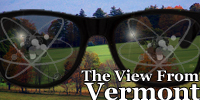 VSNAP is the Vermont State Nuclear Advisory Panel. This state panel gives advice to the state government on nuclear issues. The most recent meeting was in Montpelier, Vermont, on July 9.
VSNAP is the Vermont State Nuclear Advisory Panel. This state panel gives advice to the state government on nuclear issues. The most recent meeting was in Montpelier, Vermont, on July 9.
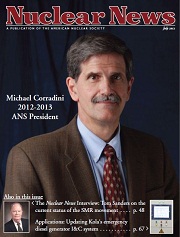 The July issue of Nuclear News magazine is available in hard copy and electronically for American Nuclear Society members (enter ANS user name and password). The issue contains the following feature articles:
The July issue of Nuclear News magazine is available in hard copy and electronically for American Nuclear Society members (enter ANS user name and password). The issue contains the following feature articles:
The Arthur M. Sackler Colloquia addresses scientific topics of broad and current interest that cut across the boundaries of traditional disciplines. "The Science of Science Communication" was a Sackler Colloquium interdisciplinary scientific meeting held at the National Academy of Sciences in Washington, D.C., on May 21-22, 2012. At this meeting, American Nuclear Society Past President Dr. Eric Loewen addressed the other "three R's" of [nuclear] education: Radiation, Reactors, and Residuals.
The New York Times reveals who did it
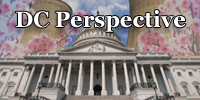 In a strongly worded unanimous decision, a federal appeals court recently upheld the Environmental Protection Agency's authority to regulate greenhouse gas emissions, as well as the EPA's "endangerment finding" that holds that those gases present a threat to human health and welfare. The court also upheld the EPA's authority to "tailor" such regulations as it sees fit, which will allow the EPA to exempt small sources of emissions and focus its regulations on large emitters (which would be more practical, and a less expensive way of reducing emissions). The court stated that the EPA's interpretation of the Clean Air Act (CAA) requirements was "unambiguously correct" and that its proposed rules were neither capricious nor arbitrary.
In a strongly worded unanimous decision, a federal appeals court recently upheld the Environmental Protection Agency's authority to regulate greenhouse gas emissions, as well as the EPA's "endangerment finding" that holds that those gases present a threat to human health and welfare. The court also upheld the EPA's authority to "tailor" such regulations as it sees fit, which will allow the EPA to exempt small sources of emissions and focus its regulations on large emitters (which would be more practical, and a less expensive way of reducing emissions). The court stated that the EPA's interpretation of the Clean Air Act (CAA) requirements was "unambiguously correct" and that its proposed rules were neither capricious nor arbitrary.
In this video interview, American Nuclear Society President Dr. Michael Corradini outlines some major goals and objectives for the Society during his upcoming term.
Following the American Nuclear Society Board of Directors meeting on Thursday, June 28, Michael Corradini officially became ANS President and Eric Loewen transitioned to ANS Immediate Past President. ANS President Corradini presented a commemorative gavel to the ANS Immediate Past President at the conclusion of Dr. Loewen's term.
The 113th Carnival of Nuclear Energy Bloggers is up at Next Big Future
Very highly recommended. On December 2, 1942, 49 scientists, led by Enrico Fermi, made history when Chicago Pile 1 (CP-1) went "critical" and produced the world's first self-sustaining, controlled nuclear chain reaction.
ANS President Eric Loewen presented many prestigious and well-deserved honors and awards during the opening plenary of the 2012 American Nuclear Society annual meeting in June. Photos and links:
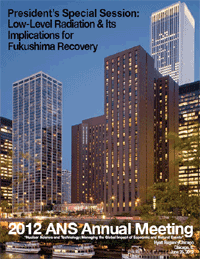 At the ANS Annual Meeting in Chicago held June 24-28, I attended the "President's Special Session on Low Level Radiation and Its Implications for Fukushima Recovery," and also the follow-on panel "Health Effects of Low-Level Radiation." The two sessions together could well have been subtitled "The Tragedy of LNT." In case you've forgotten, LNT stands for "Linear No Threshold"-the popular misconception that radiation risk is proportional to dose all the way down to zero.
At the ANS Annual Meeting in Chicago held June 24-28, I attended the "President's Special Session on Low Level Radiation and Its Implications for Fukushima Recovery," and also the follow-on panel "Health Effects of Low-Level Radiation." The two sessions together could well have been subtitled "The Tragedy of LNT." In case you've forgotten, LNT stands for "Linear No Threshold"-the popular misconception that radiation risk is proportional to dose all the way down to zero.
 Since the previous View from Vermont posted June 12, courts have issued several decisions that will have a major effect on nuclear power nationally, and on the Vermont Yankee nuclear power plant in particular. The Supreme Court ruling on the Affordable Health Care Act has moved attention from these important federal court decisions, which otherwise would have received more publicity (outside of Vermont).
Since the previous View from Vermont posted June 12, courts have issued several decisions that will have a major effect on nuclear power nationally, and on the Vermont Yankee nuclear power plant in particular. The Supreme Court ruling on the Affordable Health Care Act has moved attention from these important federal court decisions, which otherwise would have received more publicity (outside of Vermont).
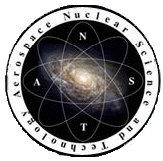 It is certainly exciting times for NASA and the space nuclear community, as physical testing of nuclear thermal rockets (NTRs) and associated components has begun at NASA and the Department of Energy laboratories across the country. Nuclear thermal propulsion, as discussed in a previous article, is just one form of nuclear propulsion with extensive research behind it, and the only form with an extensive testing background. Near-term efforts by NASA will focus on preparation for ground and flight tests of a scalable Nuclear Thermal Rocket around 2020. However, the larger purpose of the recently restarted testing track is to develop an engine for manned travel to an asteroid, and eventually to our neighboring planet, Mars.
It is certainly exciting times for NASA and the space nuclear community, as physical testing of nuclear thermal rockets (NTRs) and associated components has begun at NASA and the Department of Energy laboratories across the country. Nuclear thermal propulsion, as discussed in a previous article, is just one form of nuclear propulsion with extensive research behind it, and the only form with an extensive testing background. Near-term efforts by NASA will focus on preparation for ground and flight tests of a scalable Nuclear Thermal Rocket around 2020. However, the larger purpose of the recently restarted testing track is to develop an engine for manned travel to an asteroid, and eventually to our neighboring planet, Mars.
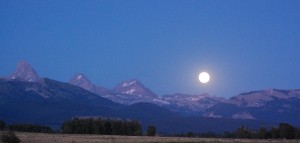
Moon rise over the Grand Tetons viewed from the site of the Driggs Hot Air Balloon Carnival. Image: L. Milam
The 112th Carnival of Nuclear Energy Bloggers is up at Atomic Insights.